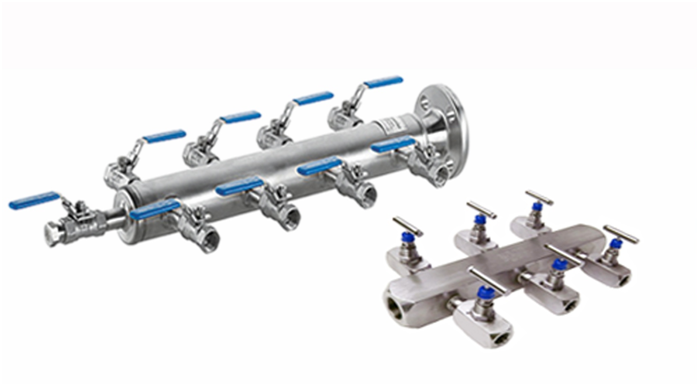
Air manifolds, also known as distribution manifolds, are a vital component of pneumatic instrumentation systems. Designed to distribute air from the compressor to the actuators, these manifolds typically have multiple outlets fitted with ball valves for isolating each component.
Air manifolds are designed to provide reliable performance in high moisture levels.In addition, a drain valve is installed at the bottom to regularly discharge condensed water from the headers and prevent water from entering the pneumatic instrument. These features ensure that the air manifold can provide reliable performance in humid environments.
The air manifold also has the additional benefit of providing diversion and distribution of air sources. This allows the air to be distributed to multiple actuators and makes it easier to control the direction and amount of air.
Overall, the air manifold is a crucial component of pneumatic instrumentation systems and is designed to provide reliable performance even in high-humidity environments. Additionally, with its ability to divert and distribute air sources, the air manifold is essential for any professional looking for reliable performance from their pneumatic instrumentation systems.
What is Air Manifold Application?
Air manifold is an integral component of industrial operations, providing an efficient and cost-effective solution for managing and distributing compressed air to multiple uses. This manifold type comprises a collection of valves and piping components designed to control airflow to its destination efficiently.
The most common application of the instrument valve manifold is to supply multiple fixed-air supply lines from a large compressor. This is common in industrial pulp and paper, chemical processing, oil and gas processing, and energy industries. Such applications typically require valves approved for low-pressure applications up to 1000 psi for either threaded or flange end connections.
The manifold is a simple yet effective solution for managing air distribution from a single large compressor, eliminating the need for multiple smaller compressors. This makes it an ideal solution for facilities that distribute air from a single source to various uses.
When selecting an instrument valve manifold, there are many factors to consider. Having the correct information before deciding is essential to ensure that the system is suitable for your needs.
- Process conditions must be considered when connecting to the flare header. Different flare headers have different process conditions, and it is vital to ensure that the valve manifold can handle the pressure, temperature, and other parameters.
- The connection size and type must also be taken into account. Different valve manifolds are designed for different types of pipe and connection sizes, so it is vital to choose the right one for your application.
- Depending on the application, it may be necessary to have a valve at the inlet. This is important for controlling the flow rate, as well as for safety reasons.
- The outlet quantity is also an essential factor. Depending on the application, it may be necessary to have a valve at the outlet or a valve with a plug.
- If the system requires an atmospheric vent port, it is essential to consider whether a valve or plug is appropriate. In some applications, a vent port is necessary to release pressure build-up and protect the system from over-pressurization.
- It may also be necessary to have a mounting bracket for the valve manifold. This is important for ensuring the system is stable and secure and making it easier to install and maintain.
- Finally, it is essential to consider whether a drain or sewer is required. A drain or sewer is necessary for some applications to prevent spills or leaks.
Considering all of these factors, selecting the right instrument valve manifold for your application is possible. It is vital to ensure that the valve manifold can handle the process conditions, has the right connections and valve types, and has all the necessary features, such as a mounting bracket and drain or sewer. Doing this ensures that your system is safe and reliable and will last many years.
Conclusion
Air manifold is an essential component of industrial processes, designed to accurately and reliably control the flow of fluids, gases, and steam. It is intended for various applications and systems, allowing for precise and consistent flow rate control. In addition, its versatility makes it an excellent choice for multiple industries and facilities, ensuring the smooth and safe operation of connected equipment and machines.






